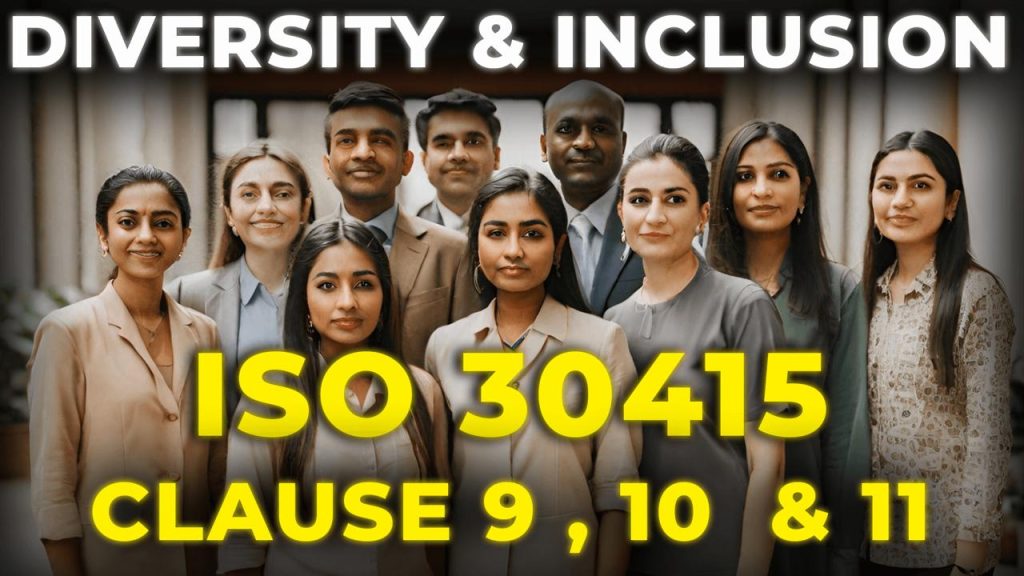Design, Supply Chain and External Stakeholders: Clause 9.0 to 11.0: ISO 30415: 2021: Diversity, Equity and Inclusion


“Race and religion do not separate people; ignorance does.” — Matshona Dhliwayo
Introduction
Universal design aims to create one experience that can be accessed and used to the greatest extent possible by all people. The design may address various topics, including accessibility, age, culture, economic situation, education, gender, geographic location, language, or race.
Read More: https://bit.ly/DEIClause4
Content: Design, Supply Chain and Stakeholders: ISO 30415: 2021: Clause 9.0 to 11.0
- What is the Design, supply chain and stakeholders in the context of DEI?
- What are the different requirements?
- Why it is important?
- How an organization can effectively implement it?
- Conclusion
Objective
As per ISO 30415: 2021 standard, developing an inclusive workplace requires an ongoing commitment to Diversity, Equity and Inclusion (DE&I) to address inequalities in organizational systems, policies, processes and practices, as well as people’s conscious and unconscious biases and behaviours.
When organizations focus on DEI during marketing, product design and stakeholder selection, the possibility of integrating it into the daily work management is enhanced.
Once you go through the article, you will understand the requirements of Design, Supply chain and Stakeholders, the four key aspects of each stage (General, Actions, Measures and Outcomes) and how an organization can effectively implement it.
Read More: https://bit.ly/DiversityEquityEnclusion
Definition: ISO 30415: 2021
Bias (3.5): Tendency, inclination or opinion that is preconceived or unreasoned that hinders impartial judgment.
Diversity (3.7): Characteristics of differences and similarities between people. Diversity includes factors that influence the identities and perspectives that people bring when interacting at work.
Employee Resource Group- ERG (3.8): People with shared demographic and other diversity dimensions, and their allies. An ERG generally consists of people who join together in a network to share experiences and beliefs, and to promote diversity and inclusion in the workplace.
Equality (3.9): State of being equal, especially in status, rights, opportunities or outcomes.
Equity (3.10): Principle that policies, processes and practices should be fairly applied and individual needs recognized.
Fairness (3.11): The principle that everyone should be subject to procedures that are equitable and as far as possible free from systematic bias.
Inclusion (3.12): Practice of including all stakeholders in organizational contexts.
Onboarding (3.16): Process of welcoming people into the organization, its culture, expectations, policies, people and their roles.
Voice (3.19): The way people communicate their views and influence matters that affect them.
Read More: https://bit.ly/DifferenceEquityEquality
Detailed Information
According to the latest “Diversity Matters Even More” report, there is a “39% increased likelihood of outperformance for those in the top quartile of ethnic and gender representation versus the bottom quartile.” Conversely, the risk of not having diversity on your leadership team is immense. Those companies lacking diverse representation are likely to be 30% lower in their performance versus their industry peers.
As per the recent study by Harvard Business Review, companies with an above-average total diversity (meaning migration, industry, career path, gender, education and age diversity), had 19% higher innovation revenues and 9% higher EBIT margins. Yet only 40% of employees agree that their manager fosters an inclusive environment!
When the organization’s top management starts looking at DEI as a business case, the implementation will increase in a real sense.
The standard is relevant to the following United Nations Sustainable Development Goals (SDGs):
- (5) Gender Equality
- (8) Decent Work and Economic Growth
- (9) Industry, Innovation and Infrastructure
- (10) Reduced Inequality.
Read More: https://bit.ly/DiffDiversityInclusion
As per ISO 30415: 2021, the following are the 3 clauses that need the attention of the top management to effectively implement the principles of DEI. They are,
- Design, Development and Delivery: Products and Services
- Procurement and Supply Chain Relationship
- External Stakeholder Relationship
The detail for each stage is bifurcated into 4 parts to clearly define it (General, Actions, Measures and Outcome).
Design, Development and Delivery: Products and Services (Clause 9.0):
| General | 1. By leveraging diverse perspectives, products and services can be more inclusive and innovative. Example: Tactile marking on the roads for the visually impaired.
2. The product and services’ Production, marketing and advertising should be aligned to DEI by using inclusive wording and imagery. Example: How a person with a disability (vision impairment) can use the product or service. |
| Actions | 1. Integrate DEI principles into the design, development and marketing of products and services and promote inclusive and respectful customer service—for example: Whitening cream to become fairer.
2. Investigate current and emerging markets to understand unique requirements and identify any unmet demands. Example: Needs and expectations of people living in the North-East. 3. Use positive images of people from diverse backgrounds and inclusive language for advertising. Example: Advertisement of ‘United Colors of Benetton’. 4. Solicit feedback about the quality of service and behaviour of the company’s representatives. 5. Collect data and evaluate risks and opportunities related to the impact of products and services. |
| Measures | 1. Trends related to the use of products and services (positive or negative).
2. Number of reported examples of inclusive and non-inclusive behaviour of the workforce. |
| Outcomes | 1. Products and services foster improved organizational sustainability.
2. Marketing and advertising are reaching to the broadest range of potential people. Example: Not focusing on a particular caste or religion. 3. People including contingent workers experience decent work, safe and secure working conditions and fair & respectful treatment. Example: Minimum wages. 4. The organization has a reputation as a provider of inclusive products and services. Example: P&G, added tactile indicators to the tops of bottles denoting the difference between shampoo and conditioner. |
Procurement and Supply Chain Relationship (Clause 10.0):
| General | 1. Integration of DEI initiatives at different stages of procurement like tendering, supplier selection and contracting. Example: Not favouring suppliers of a particular location.
2. Business strategy to have supplier diversity to broaden the range of suppliers like demographically under-represented groups to improve resilience. 3. Continual commitment of suppliers for DEI to ensure decent work, safe & secure work environment, and fair and respectful treatment of people. |
| Actions | 1. Integrate and communicate DEI principles, objectives and expectations.
2. Identify potential suppliers like demographically under-represented groups to enhance diversity and improve resilience. 3. Simplify procurement processes like documentation, supplier portal, and adoption of pre-qualification criteria to provide procurement opportunities to the broadest range of suppliers. 4. During the supplier selection process, assess HR management practices related to DEI. 5. Incorporate DEI contractual clauses to provide decent work, , a safe & secure work environment, and fair and respectful treatment of people. 6. Monitor supply chain partner performance as per DEI. 7. Share and exchange DEI experience with the supply chain. |
| Measures | 1. Number of complaints, incidents, and allegations related to bias or discrimination. |
| Outcomes | 1. Effectiveness of supplier diversity strategy.
2. Supplier’s HR policies are aligned with DEI principles. |
Read More: https://bit.ly/HRLifeCyclee
External Stakeholder Relationship (Clause 11.0):
| General | 1. External stakeholder network will vary as per the context of the organization.
2. Stakeholders can include investors, shareholders, community, educational institutes, regulatory bodies, customers, supply chain partners etc. 3. Identify the needs and expectations of these stakeholders as they can impact DEI initiatives positively or negatively. 4. A proactive, collaborative and inclusive approach should be used by the organization to build the organization’s reputation for social responsibility. |
| Actions | PLAN:
1. Recognise the needs, expectations and interests of these stakeholders. 2. Assess the importance, relative power and influence of external stakeholders to identify risks and opportunities. 3. Develop strategies based on relevance, needs, interest and power. DO: 4. Engage external stakeholders in DEI initiatives. 5. Communicate DEI principles. 6. Collect, document and review the DEI reports. CHECK: 7. Monitor the influence and impact of DEI initiatives. ACT: 8. Review the outcome. 9. Evaluate and report progress in the annual report through different channels. |
| Measures | 1. Number of DEI initiatives.
2. Changes in stakeholders’ interests, needs, expectations, power and influence over time. |
| Outcomes | 1. Broadest range of engagement with stakeholders.
2. Publicly support of DEI initiatives by stakeholders 3. Sharing of knowledge and good practices. |
Read More: https://bit.ly/DEIPDCA
Conclusion:
In the 21st century, leaders have no choice but to adopt diversity and inclusion to its core. With a surge in understanding and implementing the principles of DEI in true essence, the results will be more dynamic and fruitful. The latest research has shown many benefits of a diverse and inclusive workplace:
- Higher revenue growth
- Greater readiness to innovate.
- Improved global image and license to operate.
- Higher employee retention
Read More: https://bit.ly/EmployeeeResourceGroups
References:
ISO 30415: 2021
ISO 30408: 2016: HRM: Guidelines on Human Governance
ISO 30400: 2022: HRM: Vocabulary
Industry Experts
This is the 205th article of this Quality Management series. Every weekend, you will find useful information that will make your Management System journey Productive. Please share it with your colleagues too.
In the words of Albert Einstein, “The important thing is never to stop questioning.” I invite you to ask anything about the above subject. Questions and answers are the lifeblood of learning, and we are all learning. I will answer all questions to the best of my ability and promise to keep personal information confidential.
Your genuine feedback and response are extremely valuable. Please suggest topics for the coming weeks.

Recent Comments